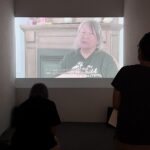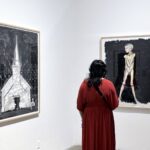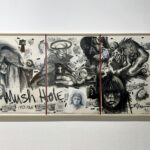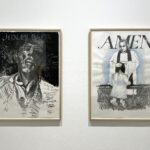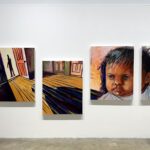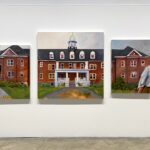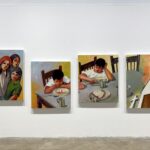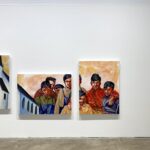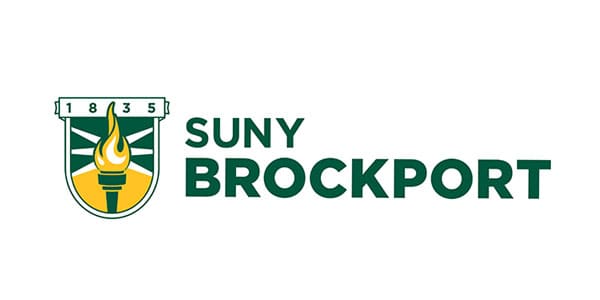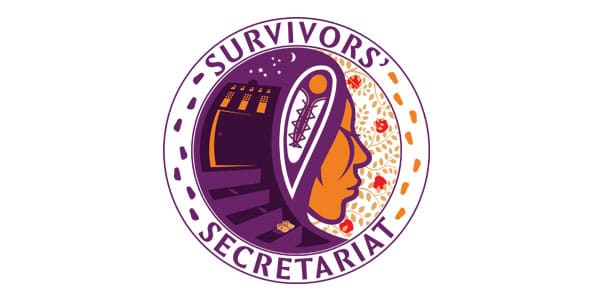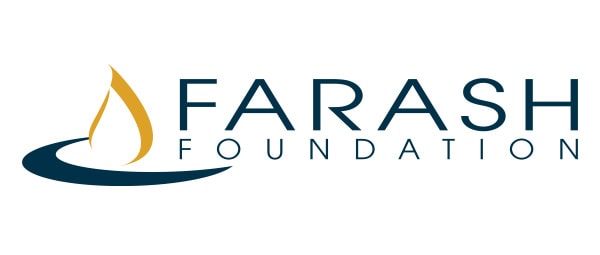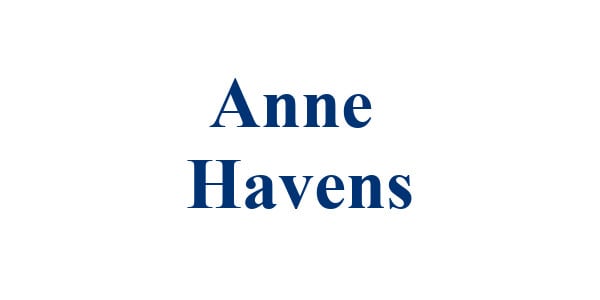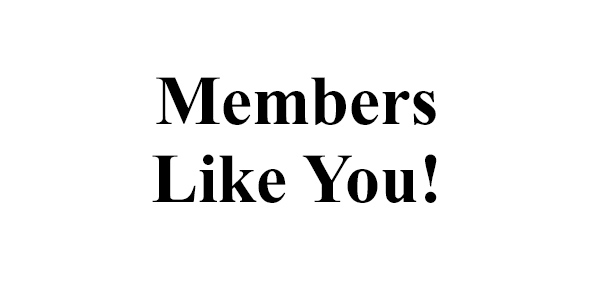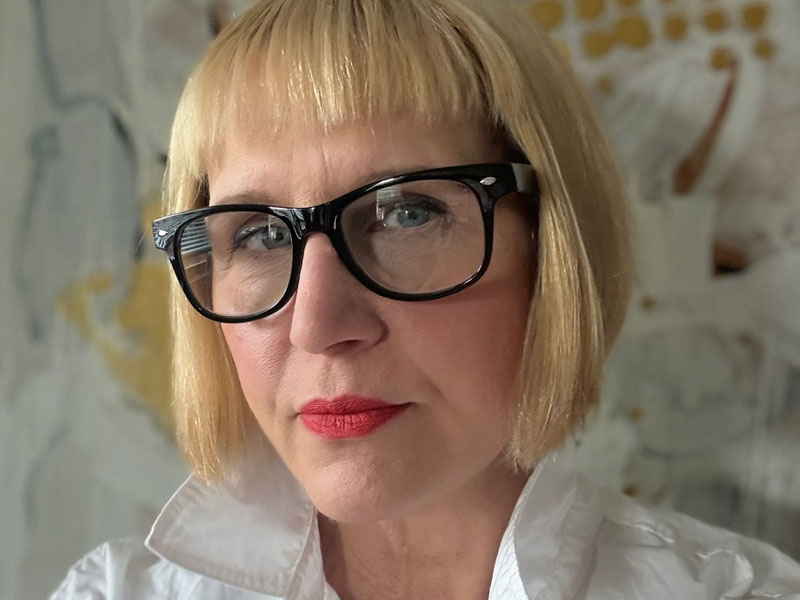August 30 - September 22, 2024
Artist & Curator Talk: August 30, 6pm
First Friday Reception: Sept. 6, 6-9pm
Resilience / Survivance / Care with Lauren Jimerson: Sept. 6, 6pm
Film Screening / Q&A with Cher Obediah: Sept. 12, 6pm
Commemoration is not just for remembering the past, but also for growing strength to transform the present and shape the future. Our Path Forward brings us to a place of truth. It is only here that healing and reconciliation can begin.
Tsi Non:we Entewaha’hara'ne features the art of R. G. Miller (Kanyen’kehà:ka / Mohawk), in response to his experience of 11 years incarcerated as a child in the Mohawk Institute Indian Residential School (also known as the Mush Hole) during 1953-1964.
Along with hundreds of thousands of other Indigenous children across North America, R. G. Miller was forcibly removed from his family and community and put into an institution that Canadian officials proclaimed was intended to “kill the Indian in the child.” In the American version of these institutions the motto was “kill the Indian, save the man.” In addition to being deprived of his language, culture, security, nutrition, love, freedom, and community, Miller was subjected to chronic terror and abuse by the priests that administered the so-called ‘school.’ The exhibit includes large oil paintings, mixed media sketches, and collages created by Miller during 2003-2008. This project is intended to show the truth about these “death houses”.
His art viscerally depicts what the Mohawk Institute actually was, what happened to him there, and how the artist continues surviving from the experience. It renounces and repudiates the genocidal silence of settler-colonialism, affirms Indigenous sovereignty through powerful visual commemoration, and is groundbreaking in North-American art worlds, Indigenous or otherwise.
The Mohawk Institute was one of hundreds of similar institutions established by the American and Canadian settler states during the 19th and 20th centuries. These “residential schools” or “boarding schools” were for colonized peoples, and the education they provided their inmates aimed at eliminating them as national groups. Multiple churches partnered with these states to manage these institutions.
Today the Indian residential school system is publicly acknowledged by Canada as part of a long settler genocide against Indigenous Peoples. Since 2010 Canada started down the path of national truth and reconciliation. Testimonials, oral histories, and artworks by living survivors like R.G. Miller are an integral part of this process. By comparison, the United States has yet to walk this path, even though it originated the idea of solving the “Indian problem” by removing children from their families, and operated more than double the number of institutions in Canada.
This exhibition is presented alongside the film ‘R.G. Miller: Truth in Painting (An Afternoon of Survivor Stories)’ by Cher Obediah.
Because of the nature of the exhibit combined with the high aesthetic skills of the artist, the viewing experience may be upsetting for some. It is not suitable for children without adult accompaniment. Emotional and mental health support will be available on site during events. The Residential School Survivors Society (IRSSS) can be contacted toll-free at 1-800-721-0066. A national Residential School Crisis Line has been set up to provide support for former students and those affected. Access emotional and crisis referral services by calling the 24-hour national crisis line: 1-866-925-4419.
ABOUT THE ARTIST
R. G. Miller is a member of the Haudenosaunee Six Nations of Grand River, and was born in a strawberry patch in Grand River Territory in 1950. He was almost three years old when he was taken away to the Mohawk Institute. He was in for 11 years of terror at the hands of the Anglican priests and their staff. He ran away multiple times but was always brought back and punished. Another technique of escape he developed in the Mushole was drawing, starting with copying figures in the occasional comic books that came his way. His ability was noticed enough that he was able to take an art class in an actual school nearby. This provided a temporary reprieve from the normalized abuse that awaited him when returned to the Mush Hole. By the time he got out (he was 14), the wounds in his soul ran deep. When he was 19, he attempted suicide by jumping off a building. Yet that same year (1969) he began formal art training at the Ontario College of Art (OCA – today known as OCAD University), where he excelled in painting, drawing, and printmaking. After six years training and then teaching at OCA, he continued his artistic development at the University of Toronto. During those Toronto years he often painted with and learned from the Ojibwa artist Arthur Shilling (who was also a Mohawk Institute Survivor). By the 1980s he became an independent artist and remains so to the present day, known for his neo-expressionist approach to portraiture and landscapes. His work is found in multiple collections in Canada and the United Kingdom. At the same time he has continually struggled with the afterlife of residential school, and repeatedly self-destructed in his personal and social life. It was not until 40 years after getting out of the Mush Hole that he was ready to create art about his experience. What he expresses in this work resonates with the experiences of tens of thousands of other Survivors. His healing journey has not ended. He is still surviving.
ABOUT THE CURATOR
Neal Keating is a settler anthropologist and curator from New York City. While a graduate student at University at Albany in the late 1990s, Keating worked as a curator/educator/associate director at The Iroquois Indian Museum in Howes Cave, NY. The first public exhibit he curated featured the basketmaking art of Mrs. Mary Adams (Akwesasne Mohawk). This was followed by exhibits of Haudenosaunee artists G. Peter Jemison, Shelley Niro, and George Longfish. In 2007 he began collaborating with R. G. Miller to produce exhibitions of his work about the Mush Hole, which continues in the 2020s. Dr. Keating is the author of the book Iroquois Art, History, and Power (Univ. of Oklahoma Press, 2012), and numerous articles on transnational Indigenous human rights movements. He is currently an Associate Professor at SUNY Brockport.
In Partnership with:
Underwritten by:
Ceeit Productions
Woodland Cultural Centre
Akwesasronon Sonatanoron
Office of the Special Interlocutor for Missing Children and
Unmarked Graves associated with Indian Residential Schools
Native North American Traveling College
Supported by:
New York State Council on the Arts
Farash Foundation
County of Monroe
Gouvernet Arts Fund
Mary S Mulligan Charitable Trust
Richard Schwartz
Anne Havens
and over 1,000 Members!






